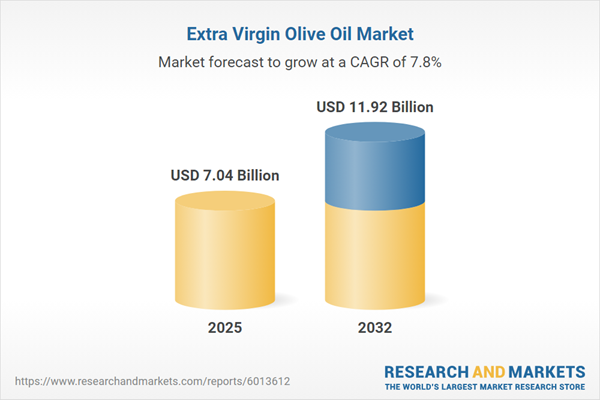Speak directly to the analyst to clarify any post sales queries you may have.
The extra virgin olive oil market is navigating a period of accelerated change as B2B leaders emphasize transparency, traceability, and operational efficiency. Aligning supply, compliance, and buyer expectations is increasingly critical for companies aiming to capture growth amid tightening regulations and evolving sourcing demands.
Market Snapshot: Extra Virgin Olive Oil Market Size and Trends
The extra virgin olive oil market is experiencing consistent growth, reaching a value of USD 6.53 billion in 2024, with projections indicating USD 7.04 billion in 2025 and a climb to USD 11.92 billion by 2032. This expansion is being driven by commercial buyers seeking verified sourcing, sustainable product lines, and digital innovations. Increased attention to quality standards and regulatory compliance is bolstering supply chain reliability. Companies are utilizing technologies such as process automation and advanced data integration, supporting seamless adaptation to certification shifts and compliance mandates. By adopting these approaches, stakeholders strengthen their competitive position as the global landscape becomes more regulated and digitally enabled.
Scope & Segmentation: Strategic B2B Opportunities
- Distribution Channels: Companies access diverse markets via direct sales, foodservice partnerships, e-commerce routes, specialized retail, supermarkets, and hypermarkets to enhance both reach and revenue.
- Packaging Types: Bulk containers, glass bottles of various sizes, PET formats, flexible pouches, and tin cans are used to meet compliance, operational efficiency, and brand presence goals.
- Product Categories: Standard, infused, and organic extra virgin olive oil varieties allow businesses to address broad commercial needs and niche contract requirements directly.
- Price Ranges: Offerings range from economically focused to premium, helping buyers align options with their operational budgets and service levels.
- End Users: Target audiences include commercial manufacturers, hospitality, restaurant and foodservice operators, and retail distributors, supporting a spectrum of business structures.
- Applications: Utilization extends beyond food, spanning cosmetics, lubricants, biofuel, and pharmaceuticals, broadening opportunities for industry partnerships and product integration.
- Extraction Processes: Centrifugal and cold-press extraction techniques ensure product purity and traceability, supporting quality control and responsible sourcing commitments.
- Regional Coverage: Strategic focus includes North America, South America, Europe, the Middle East, Africa, and Asia-Pacific, each shaped by unique certification, supply chain logistics, and regulatory frameworks.
- Leading Producers Covered: Benchmarking covers Deoleo S.A., SOVENA S.G.P.S., Salov S.p.A., BORGES International Group, Miguel Gallo e Irmãos, Colavita USA, De Cecco Alimentare, Pompeian Inc., O-Live & Co, and Carapelli Firenze S.p.A. to inform competitor assessment and planning.
Key Takeaways for Senior Decision-Makers
- Implementing full traceability across the value chain builds resilience and mitigates risk while demonstrating adherence to responsible supply practices.
- Selecting sustainable packaging solutions can differentiate brands and support compliance plans while optimizing workflows throughout the procurement and distribution lifecycle.
- Expanding digital and direct-to-market channels drives agility, supporting dynamic buyer expectations and helping organizations adapt to changing B2B purchasing habits.
- Adopting technologies for logistics and supplier management decreases vulnerability to fluctuations, ensuring steady flow even amid market shifts.
- Tailoring procurement and distribution to local market standards enables strong regulatory alignment and better engagement with region-specific buyer needs.
Tariff Impact: Navigating Evolving Trade Dynamics
Shifting U.S. tariffs continue to influence sourcing and distribution strategies, requiring organizations to maintain rigorous oversight of supplier agreements. Additional scrutiny of country-of-origin labels and certifications has become integral to maintaining compliant import and export operations. Companies prioritizing flexibility and regular monitoring are positioned to manage ongoing policy adjustments and potential supply chain interruptions.
Methodology & Data Sources
This report draws on a robust set of primary and secondary sources, including executive interviews, management-level surveys, sector publications, financial statements, and independent expert reviews. Thorough cross-referencing with PESTEL analysis frameworks and input from experienced professionals ensures actionable, high-confidence intelligence for the extra virgin olive oil sector.
Why This Report Matters: Actionable Intelligence for Market Planning
- B2B executives receive the data foundation needed to develop scalable, resilient supply chains and drive international expansion with clarity.
- Risk and compliance strategies are strengthened for smooth entry and operation within continuously evolving regulatory environments globally.
- Practical insights help leadership teams prioritize investments and align with emerging trends in sustainability and regional criteria.
Conclusion
Prioritizing verifiable practices and operational flexibility places leaders in a strong position as the extra virgin olive oil market evolves, presenting both fresh challenges and distinct growth opportunities.
Additional Product Information:
- Purchase of this report includes 1 year online access with quarterly updates.
- This report can be updated on request. Please contact our Customer Experience team using the Ask a Question widget on our website.
Table of Contents
3. Executive Summary
4. Market Overview
7. Cumulative Impact of Artificial Intelligence 2025
Companies Mentioned
The companies profiled in this Extra Virgin Olive Oil market report include:- Deoleo S.A.
- SOVENA S.G.P.S., S.A.
- Salov S.p.A.
- BORGES International Group S.L.
- Miguel Gallo e Irmãos, Lda.
- Colavita USA, Inc.
- De Cecco Alimentare S.p.A.
- Pompeian, Inc.
- O-Live & Co, S.L.
- Carapelli Firenze S.p.A.
Table Information
| Report Attribute | Details |
|---|---|
| No. of Pages | 190 |
| Published | November 2025 |
| Forecast Period | 2025 - 2032 |
| Estimated Market Value ( USD | $ 7.04 Billion |
| Forecasted Market Value ( USD | $ 11.92 Billion |
| Compound Annual Growth Rate | 7.8% |
| Regions Covered | Global |
| No. of Companies Mentioned | 11 |









